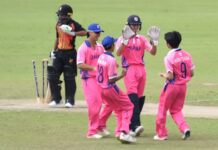Rod
OK, let’s start with a possible structure for the ODI/List A leagues. It’s probably too late to do anything meaningful about the next four-year cycle, so realistically we’re talking about 2028-30, and the qualification process for the 2031 World Cup. The 2027 event, remember, is going to be a 14-team tournament.
Suppose we start with a revived Super League, but this one involving two groups of six, made up of the top twelve sides from the 2027 World Cup. They would play three-match series home and away against the other five sides in their group, a total of 30 matches over a two-and-a-half year period (12 a year – that’s half as many as India, for example, played in the 2022 calendar year, so there would be room for friendlies if, for example, Australia and England were in different groups). The top eight from this Super League would qualify directly for the 2031 World Cup, while the bottom two from each group would play cross-over series to guard against unevenness in the two groups, with the winners going straight to the World Cup and the losers going to a World Cup Qualifier.
Below this we would have League 2, with two groups of five (or six, but let’s say five). They would play each other twice, either in three-match home-and-away series or in tri-series (Nate’s trilaterals), which have worked pretty well in the current League 2. (Note: if any Associates made it into the Super League, there would be at least a couple of Full Members involved here.) The top three from each group would go into the Qualifier, while the bottom four would play a pre-Qualifier tournament with the top four from the Challenge League.
🚨New #ECPod🚨@HeliocentCric & guest host/EC Patron @andrewnixon79 discuss:
🇳🇱 #CWC23 campaign
🇳🇦 Men’s series v🇿🇼
🇳🇵 Host tri-series before Men’s @T20WorldCup Asia Final
☘️ v 🏴 women’s tussle🎧 https://t.co/4b59mnHjPI
🍎 https://t.co/qTx3zRDE06
🟢 https://t.co/PMIFzweUvF pic.twitter.com/uyEAdPRNU8— Emerging Cricket (@EmergingCricket) October 30, 2023
That would involve the next twelve teams, again in two groups, playing six-team List A tournaments as at present. The top four would go into the pre-Qualifier, with the four leading sides from that joining two from the Super League and six from League 2 in a twelve-team Qualifier, the top six of which would qualify for the World Cup.
For the following cycle, the bottom two or four from the Challenge League should have to play off against, say, four candidate countries, perhaps based on rankings but needing to earn their place on the field rather than through a manipulable statistical system.
Essentially, this proposal tweaks the existing structure by reintroducing the Super League in a relatively painless form and extending the group system throughout. It makes reasonable allowance for the interests of the Full members, but it offers realistic qualifying pathways rather than the ridiculous two-from-ten alley which applied in this year’s Qualifier. But no doubt it could itself be improved . . .
Tom Grunshaw
Wow, what a discussion. I feel like maybe I’m late to the party but still it seems there’s much to be said:
I want to start by addressing Rod’s suggestion that we don’t need superstar players in internationals, because I don’t agree. If we want international cricket, of all formats, to retain some sense of primacy going forward we need to make sure it’s the best product it can be at all levels. If we just run series with weakened squads alongside an ever growing calendar of franchise tournaments, the international game is going to look like a side-show. I don’t think that’s what any of us want.
So if we want international cricket to remain at least one pinnacle in our game, to have proper league structures in all three formats and to let the money-men commercialise the franchise game, we (ultimately the ICC, the primary stakeholder of international cricket) are going to have to agree a compromise with the private game. Maybe this does mean breaking the calendar up into windows. It’s not optimal but given the rate of change it might be the best we can do.
When we have got eyeballs on the international game we have got to make it good as it can be, and this means filling the time we have with good tournaments. The World Test Championship is another imperfect start, although there doesn’t seem to be any plans for improvements in the near future. In time we will probably need to add a league for T20Is as well, but most immediately we need a new one for ODIs.
I love the concept of a Nations League, you can see how well it’s worked for football, both for UEFA (Europe) and CONCACAF (North & Central America and the Caribbean). Short seasons, promotion and relegation and qualification to bigger tournaments. Most importantly, it takes friendlies out of the calendar. World Rugby are eyeing up their own equivalent, it’s such a disappointment the ICC scrapped a good starting point.
“Do other sports flagellate themselves in public like this? Openly discuss its demise in the middle of its own flagship event? Does no one else think this is just a little unhinged?”@Phil_Wisden on why abolishing ODIs could be catastrophic for the game.https://t.co/fM1gAI4nSU
— Wisden (@WisdenCricket) October 27, 2023
Reflecting on the Super League, clearly it failed to capture the attention of fans, journalists and broadcasters. It’s hard to pin down why, given the World Test Championship has been well received despite having many of the same flaws. Perhaps because we didn’t have a test championship before? Perhaps the Super League didn’t actually offer enough context? Perhaps fans and journalists couldn’t see past ‘bilaterals’?
Ultimately if we want a successful relaunch of the Super League, I think it needs to feel different from bilateral friendlies. I think this means building it at least on tri-series, but maybe bigger still. This way, if boards do want to organise bilateral friendlies, it’s clear what does and what doesn’t count. Perhaps we could return to the World Cricket League days, stretched up to the very top of the ladder, having six-team, single-host tournaments, on an annual basis with promotion and relegation, and teams qualifying for a world cup at various stages of the cycle. This could in time be expanded to T20Is too, without putting a major dent in the schedule, and in a way complimentary to the short-tournaments that increasingly make up our calendar.
Rod
I didn’t actually say that, Tom. Or at least, not as baldly as you put it. My point is that a national team doesn’t cease to be a national team because a few leading players are missing. Obviously, countries will want to put out the strongest possible side, and they will do their best to schedule their matches when the major franchise leagues which most affect them aren’t playing. But if that’s not always possible they would have to cope, as the Dutch did in Zimbabwe (and sometimes in the Super League) when key players weren’t released by their counties.
As for windows, do we seriously believe that they will be anything more than arrow-slits in a medieval castle when the oligarchs have finished rolling out their franchise leagues? The IPL is expanding, there’s the BBL and the CPL, the BPL and SA T20, PSL and the Vitality Blast, not to mention the colonies being established in places like the UAE and possibly Ireland/Scotland/the Netherlands. Even with overlaps they already cover more than 300 days, and that doesn’t leave much of the year, especially between November and May, the Southern Hemisphere summer.
Either international cricket dies, or it finds a way to live with the (essentially parasitic) franchise leagues. And in my respectful submission, windows ain’t the answer! I do, on the other hand, think a WCL-type structure, which would be simpler than what I suggested above, would be an interesting alternative.
Continued on the next page







